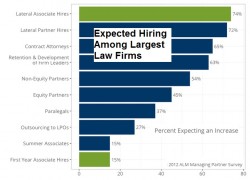 Big Law, the collective name given to firms with dozens, hundreds, and some with thousands of lawyers, is discovering something its clients have known for years: there’s a war for talent.
Big Law, the collective name given to firms with dozens, hundreds, and some with thousands of lawyers, is discovering something its clients have known for years: there’s a war for talent.
The traditional career ladder — summer associate to first-year associate to junior partner and, after 20 or so years, full partner — has given way to a dramatic rise in lateral hires and a sharp reduction in the number of entry-level lawyers. The emerging organization looks more like a diamond than a pyramid.
So much of a change has occurred over the last three decades that in 2008 the number of partners employed by the 250 largest firms outnumbered the associates. In the 10 years since 2002 when law firms hired 11,302 summer associates — the interns of the legal profession — their numbers have fallen by half, to 5,584 in 2012.
In their place firms have upped the number of lateral hires, bringing them in as senior associates or other titles, or as non-equity partners, meaning they don’t get to share in the annual profits. A 2012 survey by American Lawyer made it plain that lateral moves were on the radar of large law firms. According to the survey, 74 percent of the managing partners of these firms saw an increase in the number of lateral hires of both associates and partners. Only 15 percent saw a similar increase in hiring entry-level lawyers.
The hottest pursuit now is for associates with at least three years of experience, and skills in specific areas of the law.
Besides the profound influence this has had on law firm economics, it has also meant a significant change on how law firms handle recruiting; for example:
- It has expanded in-house recruiting, in many cases taking management of talent acquisition out of the hands of senior partners and turning it over to experienced, professional recruiters.
- It has prompted even some of the most prestigious law firms to use temps and contract attorneys to handle work once performed by junior associates.
- The number of students entering law school this year is the lowest since 1975. The 39,675 students is well off the high water year of 2010 when 52,488 first year students began school.
The growth in lateral hiring, plus the changed economics of Big Law, says James Leipold, executive director of the National Association for Law Placement, is escalating the competition. As firms do more hiring of experienced attorneys, and especially of partners, Leipold said they will, “at least in the short term,” find themselves competing for talent.
Just as firms have moved to hiring professionals to manage departments as varied as accounting and marketing, they’ve been doing the same for recruiting.
There’s “a large trend in the last five years to professionalize management,” Leipold said, including recruiting. “Firms are trying to rely more on their (internal) recruiting.”
“They are building a deeper expertise,” he said.
Especially in demand are associates with three to five years of experience, says Joe Ankus, president of Ankus Consulting, Inc. and executive director of the National Association of Legal Search Consultants. He described lawyers with that level of experience the “sweet spot” of a legal recruiter’s business.
They are “a mainstay of my business,” he says, adding that he suspects other legal recruiters who place attorneys would say the same. “That’s where the majority of the hiring is.”
He hasn’t seen much of an increase in searches, probably because law firms are keeping a lid on hiring. However, firms are hiring for certain expertise. Bankruptcy is dead, Ankus says, but real estate “is strong.”
Last week, the American Bar Association reported that first-year law school enrollment had dropped to the lowest level since 1975. The ABA said 39,675 students entered law school this fall, well off the high mark year of 2010, when 52,488 first year students enrolled.
The drop in enrollment, plus the greying of senior law firm partners, will only worsen the competition for talent.